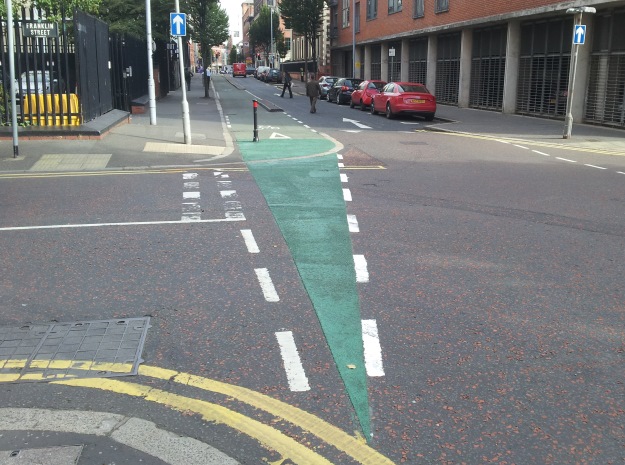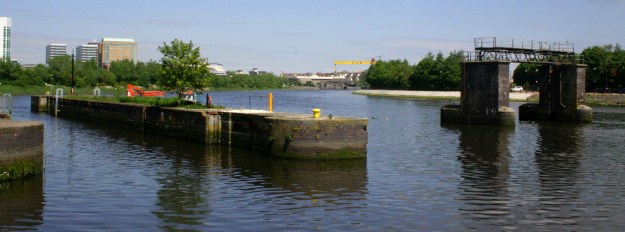
In a remarkable start to the 2013-14 Assembly session, cycling policy has made a huge leap up the agenda. Regional Development Minister Danny Kennedy has taken the first steps towards putting cycling into mainstream transport planning in Northern Ireland. Yet the talk of a cycling revolution (it’s not) needs to be tempered with the harsh realities of where we start from, what exactly is on the table, and the long struggle ahead.
Monday 9th September 2013 had been playfully dubbed #Cyclegeddon; 17 questions on cycling had been put to Ministers before the Assembly had even resumed. Putting that into context, a total of 100 questions had been asked in the past 12 months. Remarkable.
In a lengthened Regional Development Question Time, to allow for the introduction of “topical questions”, Rosie McCorley took full advantage and dropped in an early ‘blind’ question on Belfast Bike Hire. Between this and Karen McKevitt‘s scheduled question on the UK government’s announcement of £94M in cycling spending, Minister Kennedy had some bombshells ready:
Minister: “I have taken a decision to create a dedicated cycling unit that can coordinate all aspects of cycling within my Department and with other Departments. It is tasked with coordinating all cycle issues better and working with other interested stakeholders to develop robust and sustainable strategies.”
This is the core of what could develop into a very useful tool to properly direct an increased cycling budget. Questions remain over the level and source of that funding; whether it will be an annual commitment from the mainstream DRD / Roads Service budget, or the kind of one-off injections seen recently in the UK. What will be crucial is developing a coherent vision, design manual and stakeholder engagement and partnerships to ensure exploitation of every possibility of cycling infrastructure upgrading and promotion within wider government spending. Missed opportunities like the public realm scheme at Short Strand must be a thing of the past.

.
On the Gasworks Bridge, spectacularly announced during Bike Week in June:
Minister: “I [have] committed £50,000 from my Department to undertake a feasibility study of a cycle/pedestrian footbridge over the River Lagan close to the Gasworks site.”
The funding confirmation is to be welcomed and is an indication of the will to see this project through, should it prove viable. It should be a transformative piece of engineering in an area of disconnection, opening Ormeau Park as a true city centre space and making the car a less necessary option for many in south east Belfast. As high-profile as it will be, the focus for creating mass cycling conditions in Belfast must be on the wider road network and learning from international best practice.

.
A supplementary question from the winner of 2012’s Top Cycling MLA Award Peter Weir:
“What examination has been or is intended to be done, either through the new unit or the Department, of cycling infrastructure models in other jurisdictions to see what lessons can be learned for Northern Ireland?”
Minister: “There are opportunities to look at good practice, particularly on the European scene; I am thinking of Nordic countries such as Denmark, Finland etc. I am very interested in what is happening even closer to home in London, where the Boris’s bikes campaign has been such a success. If the opportunity is afforded me, I will and will certainly encourage officials to seek out opportunities and lessons that we can apply in Northern Ireland to see how we can bring forward the issue.”
While omitting the Netherlands from that list (really?), giving real weight to solutions which have worked to increase cycling uptake and safety abroad is essential. London is going some way to planning high quality separation where possible (and talking of not wasting money on half measures); tried and tested design points from the Netherlands, or cities such as Copenhagen or Seville, should be evaluated by the new cycling unit. Who knows, there may be value in bringing relevant experts who’ve delivered schemes elsewhere, looking to Belfast on the Move’s Ciarán de Búrca for a recent DRD precedent.

.
Another supplementary from Steven Agnew:
“How much value does he believe there is in a cycle lane that has cars parked all the way along it? What, if anything, is his Department doing to address the issue of cars parking in cycle lanes?”
Minister: “We want to encourage people to be careful and give particular consideration to cyclists. There are, sometimes, behavioural patterns that are not acceptable. I accept that not every cycle lane is in prime condition, and we need to address that. One benefit of having a cycling unit is that it can coordinate information of that nature, begin to address some of the infrastructure issues, ensure that the infrastructure is of real benefit to cyclists and exploit better cycling opportunities.”
Progress on this issue has been demanded by local cyclists through this blog for over a year (see DRD’s response to Reclaim Belfast’s Cycle Lanes and Reclaim Belfast’s Cycle Lanes 2) . Cycle lanes blocked every day has made a mockery of any championing of cycling by DRD. A focused effort to first address the issue and then to look at better cycle track implementation is key to cycling growth.
[youtube=http://www.youtube.com/watch?v=OvqGnlhWHGs&w=640&h=360]
.e
A final supplementary from Chris Lyttle (chair of the new All Party Group on Cycling):
“What plans does the Department have to raise the annual spend on cycling infrastructure in Northern Ireland from approximately 58p per person each year to at least £10 per person each year, as suggested by the ‘Get Britain Cycling’ report that was roundly endorsed by the Westminster Parliament?”
Minister: “We are starting at a realistically low base, and we are in economically challenging times, but the very fact that we are creating a cycling unit is a clear indication of our intentions, which are that we want to make progress and exploit opportunities. If there are opportunities for further funding, whether through the Executive locally or through Europe, we will certainly try to explore those. I have no doubt that you and the all-party cycling group will want to encourage and support that.”
The shocking current level of underinvestment in cycling was raised on this blog during the summer, and that 58p (not challenged by the Minister) goes some way to explaining our historic suppressed cycling levels – only Malta and Cyprus have a lower transport cycling percentage than Northern Ireland. The world over, investment in cycling has been shown to have a great societal return on investment, whether by reduced traffic congestion, more active lifestyles, even an economic uplift for local businesses by protected cycle lanes. There is plenty of DRD money for transport and infrastructure projects; cycling just needs a more realistic and aspirational share.
Minister: “We can promote and encourage cycling not only as a sustainable mode of travel but as something that genuinely improves people’s lifestyles”
Amen to that.
While welcoming the Minister’s comments on £4 million devoted to active travel projects in 4 council areas, this was previously announced and does not represent new spending. Similarly, while there is great work in the active travel schools programme, the cycling element remains subsumed within a largely walking target, and will continue to flounder around 1% until wider road infrastructure is improved to create realistic alternatives to the car-dominated school run.
#Cyclegeddon continues with a further 16 questions on cycling due to be answered by various Ministers over the coming days. The topics are diverse and get to the heart of some troubling issues, including:
- An update on taxis in bus lanes (an opportunity for the Minister to finally come down in favour of cycling concerns)
- Issues relating to Translink’s policies on carriage of bicycles by train
- DOE plans reduce the number of road deaths and serious injuries amongst cyclists
- Special focus on penalties for parking in cycle lanes
- Whether DRD consulted cycling groups on this planned change to East Bridge Street
- Cycle hoop provision across local council areas
Cycling groups have seen big announcements before, cycling budgets rise and fall, political commitment wax and wane. With the creation of a cycling unit there is hope for DRD quietly going about the business of transforming our streets and roads with the minimum of fuss. Many of the great cycling cities became so by just getting on with the job, and Belfast especially has the chance to rise above many other UK cities with targeted investment. The work of the All Party Group on Cycling promises to keep minds focused at Stormont on the challenges ahead. Today’s progress must be welcomed, but we must also realise the the NI Executive has just left the door ajar for everyone to demand better cycling provision and safety – it’s up to us to stick our foot in the door and force it wide open.
Read the full Hansard report on the #Cyclegeddon Assembly session.
UPDATE Tuesday 10th September: The Irish government have made that “cycling revolution” tag look even more foolish, when it was linked to the promise of 4.5km of new cycle lanes. Their plan, mainly around Dublin and adjoining counties, is to add 2,300km of new cycle lanes – no hyperbole, no fuss, just “meeting cyclists’ needs“. A lesson in just getting on with the job?
